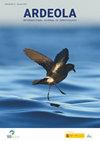Population Decline of the Capercaillie Tetrao urogallus aquitanicus in the Central Pyrenees
IF 1.2
4区 生物学
Q2 ORNITHOLOGY
引用次数: 6
Abstract
Summary. Long-term monitoring of endangered birds is essential to estimate population trends and to identify potential causes of population decline. This is particularly important for alpine birds inhabiting mountain areas at the boundaries of their range. Here we analyse the population trend of Capercaillie in the Spanish Central Pyrenees based on annual surveys carried out between 2000 and 2017. We found a significant population decline (around 58%) in the number of birds counted in leks. Most capercaillies inhabit coniferous forests of Black Pine with abundant Bilberry and Rhododendron understorey. The number of males declined at lower altitudes and in more exposed orientations, in a scenario consistent with the differential rate of loss of habitat quality due to climate change. We hypothesised that one of the main causes of the Capercaillie decline could be low breeding success (average annual productivity 0.67 chicks per female). In light of the decline rates observed, the Pyrenean population should be relisted as endangered in the Spanish National Catalogue of Endangered Species. Affording a higher degree of protection should guarantee the adoption of management measures to reverse or slow down the general trend of decline of the species in the south of its range.—Gil, J.A., Gómez-Serrano, M.Á. & López-López, P. (2020). Population decline of the Capercaillie Tetrao urogallus aquitanicus in the Central Pyrenees. Ardeola, 67: 285-306.中庇里牛斯山四尾黄颡鱼种群数量的下降
总结。对濒危鸟类进行长期监测对于估计种群趋势和确定种群减少的潜在原因至关重要。这对栖息在其活动范围边界山区的高山鸟类尤为重要。在这里,我们根据2000年至2017年期间进行的年度调查,分析了西班牙中比利牛斯山脉Capercaillie的人口趋势。我们发现在韭葱中计数的鸟类数量显著下降(约58%)。大部分的山莓属植物栖息在有丰富的越橘和杜鹃花下层的黑松针叶林中。在海拔较低和暴露方向较多的情况下,雄性数量下降,这与气候变化导致的生境质量损失的差异率一致。我们假设Capercaillie数量下降的主要原因之一可能是繁殖成功率低(平均每只雌性每年生产0.67只雏鸟)。鉴于所观察到的下降速度,比利牛斯山脉的人口应该在西班牙国家濒危物种目录中重新列为濒危物种。提供更高程度的保护应保证采取管理措施,以扭转或减缓该物种在其活动范围南部下降的总趋势。-吉尔,j.a., Gómez-Serrano, M.Á。& López-López, P.(2020)。中庇里牛斯山黑头蝽种群数量的下降。中国生物医学工程学报,32(6):385 - 396。
本文章由计算机程序翻译,如有差异,请以英文原文为准。
求助全文
约1分钟内获得全文
求助全文
来源期刊
CiteScore
2.30
自引率
6.20%
发文量
16
审稿时长
>12 weeks
期刊介绍:
Ardeola: International Journal of Ornithology is the scientific journal of SEO/BirdLife, the Spanish Ornithological Society. The journal had a regional focus when it was first published, in 1954. Since then, and particular during the past two decades, the journal has expanded its thematic and geographical scope. It is now a fully international forum for research on all aspects of ornithology. We thus welcome studies within the fields of basic biology, ecology, behaviour, conservation and biogeography, especially those arising from hypothesis-based research. Although we have a long publication history of Mediterranean and Neotropical studies, we accept papers on investigations worldwide.
Each volume of Ardeola has two parts, published annually in January and July. The main body of each issue comprises full-length original articles (Papersand Review articles) and shorter notes on methodology or stimulating findings (Short Communications). The publication language is English, with summaries, figure legends and table captions also in Spanish. Ardeolaalso publishes critical Book Reviewsand PhD-Dissertation Summaries; summarising ornithological theses defended in Spain. Finally there are two Spanish-language sections, Ornithological News; summarising significant recent observations of birds in Spain, and Observations of Rare Birds in Spain, the annual reports of the Spanish Rarities Committee.

 求助内容:
求助内容: 应助结果提醒方式:
应助结果提醒方式:


